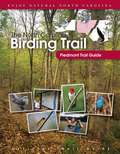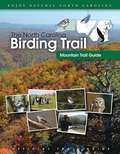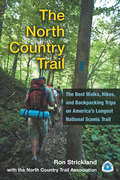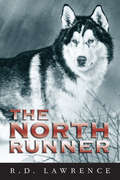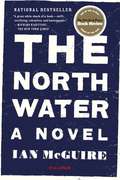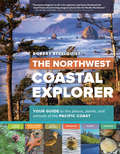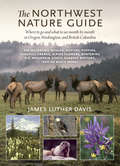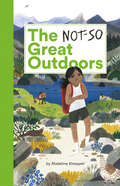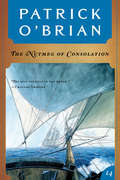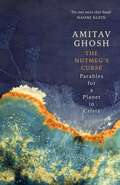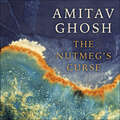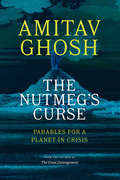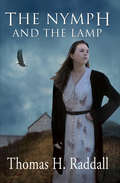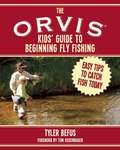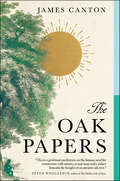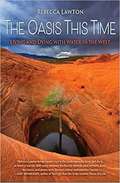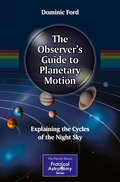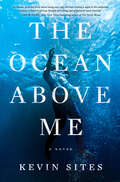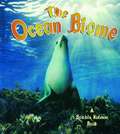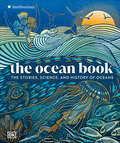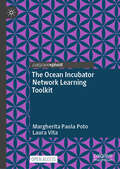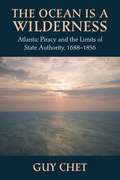- Table View
- List View
The North Carolina Birding Trail
by North Carolina Birding TrailNorth Carolina harbors an incredible diversity of habitats that provide food and shelter for more than 440 bird species throughout the year, making the state a destination for birders and nature lovers. The North Carolina Birding Trail is a driving trail linking birders and tourists with great birding sites across the state and the local communities in which they are found.The second of three regional guides, the Piedmont Trail Guide presents 103 premier birding destinations in the North Carolina piedmont, most within an easy drive of the state's urban centers, between Charlotte on the west and Interstate 95 on the east. The spiral-bound volume features maps, detailed site descriptions, and color photographs throughout. Each site description includes directions as well as information on access, focal species and habitats, and on-site visitor amenities. Special "while you're in the area" listings accompany each of fourteen site groupings, so visitors can travel to a cluster of birding destinations and enjoy other local highlights and attractions along the way.
The North Carolina Birding Trail
by North Carolina Birding TrailNorth Carolina harbors an incredible diversity of habitats that provide food and shelter for more than 440 bird species throughout the year, making the state a destination for birders and nature lovers. The North Carolina Birding Trail is a driving trail linking birders and tourists with great birding sites across the state and the local communities in which they are found.The first of three regional guides, the Coastal Plain Trail Guide presents 102 birding destinations east of Interstate 95. The spiral-bound volume features maps, detailed site descriptions, and color photographs throughout. Each site description includes directions as well as information on access, focal species and habitats, and on-site visitor amenities. Special "while you're in the area" listings accompany each of sixteen site groupings, so visitors can travel to a cluster of birding destinations and enjoy other local highlights and attractions along the way.
The North Country Trail: The Best Walks, Hikes, and Backpacking Trips on America’s Longest National Scenic Trail
by North Country Trail Association Ron StricklandThe North Country Trail is the longest of America's eleven congressionally designated National Scenic Trails. Winding through seven states--New York, Pennsylvania, Ohio, Michigan, Wisconsin, Minnesota, and North Dakota--the NCT's 4,600 miles attract more than one million visitors annually. These hikers are treated to a smorgasbord of Upper Midwest hiking featuring everything from urban strolls to backcountry adventure through mountains, rivers, prairies, and shoreline. This book is the definitive guide for NCT hikers--whether first-timers, seasoned backpackers, or any level in between--who wish to maximize their experience on this splendid trail. In addition to a full overview of the trail's tread in each state, the guide describes in detail forty of the NCT's premier segments, with helpful information including easy-to-read trail descriptions, physical and navigation difficulties, trail highlights, hiking tips, and precise maps incorporating the latest GPS technology.
The North Runner
by R. D. Lawrence Max FinkelsteinThe North Runner is a true and moving story of the building of trust between a man and an exceptional dog that was half wolf, half Alaskan Malamute, and the resulting mutual affection and respect between them.
The North Water: A Novel
by Ian Mcguire<P>A nineteenth-century whaling ship sets sail for the Arctic with a killer aboard in this dark, sharp, and highly original tale that grips like a thriller. <P>Behold the man: stinking, drunk, and brutal. Henry Drax is a harpooner on the Volunteer, a Yorkshire whaler bound for the rich hunting waters of the arctic circle. Also aboard for the first time is Patrick Sumner, an ex-army surgeon with a shattered reputation, no money, and no better option than to sail as the ship's medic on this violent, filthy, and ill-fated voyage. <P>In India, during the Siege of Delhi, Sumner thought he had experienced the depths to which man can stoop. He had hoped to find temporary respite on the Volunteer, but rest proves impossible with Drax on board. <P>The discovery of something evil in the hold rouses Sumner to action. And as the confrontation between the two men plays out amid the freezing darkness of an arctic winter, the fateful question arises: who will survive until spring? <P>With savage, unstoppable momentum and the blackest wit, Ian McGuire's The North Water weaves a superlative story of humanity under the most extreme conditions. <P><b>A New York Times Bestseller</b>
The Northwest Coastal Explorer: Your Guide to the Places, Plants, and Animals of the Pacific Coast
by Robert Steelquist“Part field guide, part travel guide, Steelquist writes with the authoritative voice of that friend you want next to you on the trail or in the dunes—the one who knows just where to go for a weekend getaway and what to pack for the Pacific Northwest’s unpredictable weather.” —Portland Monthly Millions of visitors explore the magnificent coastline of the Pacific Northwest and all that it provides—unique plant life, easy-to-find animals, and magical places. The Northwest Coastal Explorer is a fun, engaging, lushly-illustrated guide to the marine life of Oregon, Washington, and British Columbia. Profiles of the flora and fauna include tips on where and how to find them—like the ochre sea stars commonly discovered on exposed rocks and the olive snails found on sandy beaches—while the included getaway guide highlights the best weekend trips for each area.
The Northwest Nature Guide: Where to Go and What to See Month by Month in Oregon, Washington, and British Columbia
by James Luther DavisFrom winter whale watching to autumn seabirding, The Northwest Nature Guide offers more than 170 best bets for wildlife adventures throughout Oregon, Washington, and British Columbia—as well as your own backyard. With contagious enthusiasm and irrepressible humor, James Luther Davis shares his insider tips, helpful maps, and experience to guarantee readers know where they need to go to see nature at its peak every month of the year. Whatever the season and no matter the weather, Davis entices nature lovers of all ages to discover what they might otherwise miss. The intrepid may find the three-toed woodpecker or even Sasquatch. The inquisitive will learn why auks fly but penguins don't. Everyone will discover outdoor adventures that revitalize, inspire, and renew their appreciation for nature. Whether it's tidepooling by the shore, newt pursuit in the woods, or trailing bighorn sheep in the mountains, this practical guide helps make the most of every fresh-air opportunity.
The Norton Book of Nature Writing, College Edition
by Robert Finch John ElderThe Norton Book of Nature Writing, College Edition offers, for the first time, a paperback edition of this ground-breaking anthology. In addition to its significantly expanded table of contents, the new version has been augmented by a Field Guide for teachers and students, written by Lilace Mellin Guignard, a writer and teacher at the Center for Environmental Literature of the University of Nevada at Reno. The Field Guide includes a thematic table of contents with useful groupings of the readings and a set of three study questions for each selection. These questions call attention to literary techniques and themes, suggest connections among various authors in the collection, and invite response to the personal or political challenges posed by particular selections. For students, these questions may offer a further context for their initial encounters with these readings and help to identify rich areas to explore further in their own writing. For teachers, they may serve as prompts for student journals or as topics for discussion in class.
The Not-So Great Outdoors
by Madeline KloepperA reluctant camper discovers that the (not-so) great outdoors can be just as exciting as screens and skyscrapers in this playful picture book celebration of the pleasures of unplugging and embracing nature.What's so great about the "great outdoors"? A grumpy urban kid begrudgingly accompanies her family on a summer camping trip, missing all the sublime sights right under her nose as she longs for the lights and stimulation of the city. But as she explores forests, lakes and mountains, and encounters bears, beavers and caribou, she slowly comes to realize that the simpler things are just as sparkly, that the sky is its own majestic light show, and the symphony is all around. The Not-So Great Outdoors is a humorous and richly imagined reminder of the beauty and magic that can be found away from the city and our screens.
The Not-So-Cuddly Cassowary (Fountas & Pinnell LLI Purple #Level P)
by Carmen MoraisThe cassowary isn't like most birds. This human sized creature doesn't fly, can't sing, and can kill a person with a single swipe of its powerful claws. This unique, endangered animal may sound hard to love, but many of its human neighbors say it is a gentle creature that deserves our help.
The Nutmeg of Consolation (Vol. Book 14) (Aubrey/Maturin Novels)
by Patrick O'Brian"[The series shows] a joy in language that jumps from every page....You're in for a wonderful voyage."--Cutler Durkee, People Shipwrecked on a remote island in the Dutch East Indies, Captain Aubrey, surgeon and secret intelligence agent Stephen Maturin, and the crew of the Diane fashion a schooner from the wreck. A vicious attack by Malay pirates is repulsed, but the makeshift vessel burns, and they are truly marooned. Their escape from this predicament is one that only the whimsy and ingenuity of Patrick O'Brian--or Stephen Maturin--could devise. In command now of a new ship, the Nutmeg, Aubrey pursues his interrupted mission. The dreadful penal colony in New South Wales, harrowingly described, is the backdrop to a diplomatic crisis provoked by Maturin's Irish temper, and to a near-fatal encounter with the wildlife of the Australian outback.
The Nutmeg's Curse: Parables for a Planet in Crisis
by Amitav Ghosh'Do not miss this book' NAOMI KLEIN, author of This Changes EverythingThe history of the nutmeg is one of conquest and exploitation - of both human life and the natural environment - and the origin of our contemporary climate crisis.Tracing the threats to our future to the discovery of the New World and the sea route to the Indian Ocean, The Nutmeg's Curse argues that the dynamics of climate change are rooted in a centuries-old geopolitical order constructed by Western colonialism. The story of the nutmeg becomes a parable revealing the ways human history has always been entangled with earthly materials - spices, tea, sugarcane, opium, and fossil fuels. Our crisis, Ghosh shows, is ultimately the result of a mechanistic view of the earth, where nature exists only as a resource for humans to use for our own ends, rather than a force of its own, full of agency and meaning.Writing against the backdrop of the global pandemic and the Black Lives Matter protests, Ghosh frames these historical stories in a way that connects our shared colonial past with the deep inequality we see around us today. By interweaving discussions on everything from the global history of the oil trade to the migrant crisis and the animist spirituality of indigenous communities around the world, The Nutmeg's Curse offers a sharp critique of contemporary society and speaks to the profoundly remarkable ways in which human history is shaped by non-human forces.
The Nutmeg's Curse: Parables for a Planet in Crisis
by Amitav Ghosh'Do not miss this book' NAOMI KLEIN, author of This Changes EverythingFrom the bestselling author of the Ibis trilogy and The Great Derangement, The Nutmeg's Curse is an enthralling, panoramic history of the influence of colonialism on the world today, told through the surprising story of the nutmeg.The history of the nutmeg is one of conquest and exploitation - of both human life and the natural environment - and the origin of our contemporary climate crisis.Tracing the threats to our future to the discovery of the New World and the sea route to the Indian Ocean, The Nutmeg's Curse argues that the dynamics of climate change are rooted in a centuries-old geopolitical order constructed by Western colonialism. The story of the nutmeg becomes a parable revealing the ways human history has always been entangled with earthly materials - spices, tea, sugarcane, opium, and fossil fuels. Our crisis, Ghosh shows, is ultimately the result of a mechanistic view of the earth, where nature exists only as a resource for humans to use for our own ends, rather than a force of its own, full of agency and meaning.Writing against the backdrop of the global pandemic and the Black Lives Matter protests, Ghosh frames these historical stories in a way that connects our shared colonial histories with the deep inequality we see around us today. By interweaving discussions on everything from the global history of the oil trade to the migrant crisis and the animist spirituality of indigenous communities around the world, The Nutmeg's Curse offers a sharp critique of contemporary society and speaks to the profoundly remarkable ways in which human history is shaped by non-human forces.(P) 2021 Hodder & Stoughton Limited
The Nutmeg's Curse: Parables for a Planet in Crisis
by Amitav GhoshThe author of The Great Derangement finds the origins of our climate crisis in Western colonialism&’s violent exploitation of human life and the environment. A powerful work of history, essay, testimony, and polemic, Amitav Ghosh&’s new book traces our contemporary planetary crisis back to the discovery of the New World and the sea route to the Indian Ocean. The Nutmeg&’s Curse argues that the dynamics of climate change today are rooted in a centuries-old geopolitical order constructed by Western colonialism. At the center of Ghosh&’s narrative is the now-ubiquitous spice nutmeg. The history of the nutmeg is one of conquest and exploitation—of both human life and the natural environment. In Ghosh&’s hands, the story of the nutmeg becomes a parable for our environmental crisis, revealing the ways human history has always been entangled with earthly materials such as spices, tea, sugarcane, opium, and fossil fuels. Our crisis, he shows, is ultimately the result of a mechanistic view of the earth, where nature exists only as a resource for humans to use for our own ends, rather than a force of its own, full of agency and meaning. Writing against the backdrop of the global pandemic and the Black Lives Matter protests, Ghosh frames these historical stories in a way that connects our shared colonial histories with the deep inequality we see around us today. By interweaving discussions on everything from the global history of the oil trade to the migrant crisis and the animist spirituality of Indigenous communities around the world, The Nutmeg&’s Curse offers a sharp critique of Western society and speaks to the profoundly remarkable ways in which human history is shaped by non-human forces.
The Nymph and the Lamp: A Novel
by Thomas H RaddallFrom an award-winning, master storyteller, a classic love story set on a barren, post-World War I island known for its shipwrecks. A Nova Scotia classic, The Nymph and the Lamp is the story of Isabel Jardin, a strong and sensitive woman, and the men in her life—the stoic Matthew Carney, a living legend, the passionate Gregory Skane, and the innocent but infatuated Jim Sargent. Set in the 1920s, the story unfolds against the wild desolation of Marina, a wind-swept island off the coast of Nova Scotia, as the characters come to terms with their personal contradictions and the demands of isolated island life.
The ORVIS Kids' Guide to Beginning Fly Fishing: Easy Tips To Catch Fish Today
by Tyler BefusKids can fly fish, too! Fifteen-year-old Tyler Befus loves to fly fish. He has won awards and traveled all over the world to fish in different places. In this guide, Tyler shows that any kid can learn to fly fish. Discover fascinating information about where fish live and what fish eat, and learn tips about what equipment you’ll need, casting techniques, and much, much more to get you started on your own fly-fishing adventure. Fly fishing is an awesome way to spend time outdoors with your family, and with this book, any kid can become an expert!The ORVIS Kids’ Guide to Beginning Fly Fishing is filled with a personal collection of photos and drawings done by Tyler himself. Because it has been written by an actual kid, this fully revised and updated book is a one-of-a-kind guide that kids can understand and easily learn from. Filled with all kinds of great tips and tricks, this is a valuable resource for any kid who wants to know more about fishing. After all, fly fishing isn’t just for the adults!For fishing enthusiasts ages 8 and up, this is the perfect first stop shop for learning all you can about fly fishing. The pefect gift for those who love to fish and want to teach younger kids the skills behind fly fishing or for that kid who just loves reading about the outdoors.
The Oak Papers
by James Canton"A profound meditation on the human need for connection with nature, as one man seeks solace beneath the bows of an ancient oak tree."—Peter Wohlleben, author of The Hidden Life of Trees"James Canton knows so much, writes so well and understands so deeply about the true forest magic and the important place these trees have in it. Knowledge and joy."— Sara Maitland, author of How to Be AloneJoining the ranks of The Hidden Life of Trees and H is for Hawk, an evocative memoir and ode to one of the most majestic living things on earth—the oak tree—probing the mysteries of nature and the healing role it plays in our lives.Thrown into turmoil by the end of his long-term relationship, Professor James Canton spent two years meditating [PA1]beneath the welcoming shelter of the massive 800-year-old Honywood Oak tree in North Essex, England. While considering the direction of his own life, he began to contemplate the existence of this colossus tree. Standing in England for centuries, the oak would have been a sapling when the Magna Carta was signed in 1215.In this beautiful, transportive book, Canton tells the story of this tree in its ecological, spiritual, literary, and historical contexts, using it as a prism to see his own life and human history. The Oak Papers is a reflection on change and transformation, and the role nature has played in sustaining and redeeming us. Canton examines our long-standing dependency on the oak, and how that has developed and morphed into myth and legend. We no longer need these sturdy trees to build our houses and boats, to fuel our fires, or to grind their acorns into flour in times of famine. What purpose, then, do they serve in our world today? Are these miracles of nature no longer necessary to our lives? What can they offer us? Taking inspiration from the literary world—Henry David Thoreau, Leo Tolstoy, Katherine Basford’s Green Man, Thomas Hardy, William Shakespeare, and others—Canton ponders the wondrous magic of nature and the threats its faces, from human development to climate change, implores us to act as responsible stewards to conserve what is precious, and reminds us of the lessons we can learn from the world around us, if only we slow down enough to listen.
The Oak Ridges Moraine Battles
by Gerda R. Wekerle L. Anders Sandberg Liette GilbertThe Oak Ridges Moraine is a unique landform that generated heated battles over the future of nature conservation, sprawl, and development in the Toronto region at the turn of the twenty-first century. This book provides a careful, multi-faceted history and policy analysis of planning issues and citizen activism on the Moraine's future in the face of rapid urban expansion.The Oak Ridges Moraine Battles captures the hidden aspects of a story that received a great deal of attention in the local and national news, and that ultimately led to provincial legislation aimed at protecting the Moraine and Ontario's Greenbelt. By giving voice to a range of actors - residents, activists, civil servants, scientists, developers and aggregate and other resource users, the book demonstrates how space on the urban periphery was reshaped in the Toronto region. The authors ask hard questions about who is included and excluded when the preservation of nature challenges the relentless process of urbanization.
The Oasis This Time
by Rebecca LawtonWater, the most critical fluid on the planet, is seen as savior, benefactor, and Holy Grail in these fifteen essays on natural and faux oases. Fluvial geologist and former Colorado River guide Rebecca Lawton follows species both human and wild to their watery roots—in warming deserts, near rising Pacific tides, on endangered, tapped-out rivers, and in growing urban ecosystems. Lawton thoroughly and eloquently explores human attitudes toward water in the West, from Twentynine Palms, California, to Sitka, Alaska. A lifelong immersion in all things water forms the author's deep thinking about living with this critical compound and sometimes dying in it, on it, with too much of it, or for lack of it. The Oasis This Time, the inaugural Waterston Desert Writing Prize winner, is a call for us to evolve toward a sustainable and even spiritual connection to water. REBECCA LAWTON grew up exploring rivers and deserts throughout the American West. Her writing on water, climate, and wild and human nature has been honored with a Fulbright Visiting Research Chair, the Ellen Meloy Award for Desert Writers, the Waterston Desert Writing Prize, a WILLA for original softcover fiction, Pushcart Prize nominations in prose and poetry, and residencies at Hedgebrook, PLAYA, and The Island Institute. She lives with guitarist Paul Christopulos in Summer Lake, Oregon, where she directs PLAYA's residency program for writers, artists, and scientists.
The Observer's Guide to Planetary Motion
by Dominic FordTo the naked eye, the most evident defining feature of the planets is their motion across the night sky. It was this motion that allowed ancient civilizations to single them out as different from fixed stars. "The Observer's Guide to Planetary Motion" takes each planet and its moons (if it has them) in turn and describes how the geometry of the Solar System gives rise to its observed motions. Although the motions of the planets may be described as simple elliptical orbits around the Sun, we have to observe them from a particular vantage point: the Earth, which spins daily on its axis and circles around the Sun each year. The motions of the planets as observed relative to this spinning observatory take on more complicated patterns. Periodically, objects become prominent in the night sky for a few weeks or months, while at other times they pass too close to the Sun to be observed. "The Observer's Guide to Planetary Motion" provides accurate tables of the best time for observing each planet, together with other notable events in their orbits, helping amateur astronomers plan when and what to observe. Uniquely each of the chapters includes extensive explanatory text, relating the events listed to the physical geometry of the Solar System. Along the way, many questions are answered: Why does Mars take over two years between apparitions (the times when it is visible from Earth) in the night sky, while Uranus and Neptune take almost exactly a year? Why do planets appear higher in the night sky when they're visible in the winter months? Why do Saturn's rings appear to open and close every 15 years? This book places seemingly disparate astronomical events into an understandable three-dimensional structure, enabling an appreciation that, for example, very good apparitions of Mars come around roughly every 15 years and that those in 2018 and 2035 will be nearly as good as that seen in 2003. Events are listed for the time period 2010-2030 and in the case of rarer events (such as eclipses and apparitions of Mars) even longer time periods are covered. A short closing chapter describes the seasonal appearance of deep sky objects, which follow an annual cycle as a result of Earth's orbital motion around the Sun.
The Ocean Above Me: A Novel
by Kevin Sites"An intense and powerful novel about losing one’s way and then finding it again in the unlikeliest of places. I found it moving, thought-provoking and gripping in equal measure." -- Ian McGuire, New York Times bestselling author of The North WaterTrapped undersea in a capsized shrimping trawler, a damaged former war correspondent is forced to confront a deadly secret from his past as he struggles to survive in this gripping novel of trauma, loss, love, and redemption from award-winning journalist and author of The Things They Cannot Say Kevin Sites.Former war correspondent Lukas Landon is alone, trapped under 150-feet of water in an overturned shrimp trawler at the bottom of the ocean. The only thing keeping him alive is an air bubble in the ship’s bow. But the water level is rising, and time is running out. Landon doesn’t know if he will survive . . . or if he even deserves to.After years of covering bloody battles in Afghanistan and Iraq, Landon’s once promising life took a steep nosedive. But he may have found a path to redemption: a series of in-depth stories on the Philomena, the rarest of South Carolina shrimp boats skippered by decorated former army sergeant Clarita Esteban.A Black woman struggling to survive in a white man’s world, Clarita has assembled a crew of misfits as deeply wounded as herself; a Cuban first mate who came to America during the Mariel boatlift and his troubled younger cousin; a quiet Haitian cook with a secret black book; a deckhand, the only member of the ship’s former crew willing to work for a Black female skipper; and Clarita’s daughter, who lost a college basketball scholarship to an injury.As Landon slowly earns the disparate crew’s trust, uncovering their pasts—and how each landed aboard this rusty bucket of bolts with its own shaded history—he keeps his own story and the events that unmoored the foundation of his life a secret. But when catastrophe strikes—leaving him twenty-fathoms deep in exquisite isolation—Landon has no one to question but himself. Will he finally come clean? And if he does, will he make it out alive from this 110-ton steel tomb under the sea to finally tell the truth to those who need to hear it?A thrilling fight for survival and a poignant story of loss and redemption, The Ocean Above Me is a literary masterpiece that explores the effects of trauma, the pain of forgiveness, and the light of love that burns in the darkest depths.
The Ocean Biome (The Living Ocean Series)
by Kathryn SmithymanThe four zones of the marine bio me,their plants and animals, coral reefs and estuaries, the importance of oceans to the Earth, and how they are in danger.
The Ocean Book: The Stories, Science, and History of Oceans (DK Nature Books)
by DKImmerse yourself in this beautiful, absorbing guide to the marine world. Earth owes its identity as the blue planet to the vast oceans of water that cover almost 70 percent of its surface. Home to an abundance of marine life and vital in regulating Earth's climate, the oceans are also the scene of daring exploits of exploration, intense rivalries between trading empires, and global warfare. Combining arresting photography; rich illustrations; and engaging, expertly written text, The Ocean Book showcases the landscapes; plants and animals; and captivating human stories of the world's oceans. Whether you're interested in blue whales, the El Nino climate oscillation, the search for the Northwest Passage, the sinking of Titanic, or pirates, this is the perfect exploration of the ocean realm.
The Ocean Incubator Network Learning Toolkit
by Margherita Paola Poto Laura VitaThis open access book is designed to enhance ocean literacy through diverse research, educational and interdisciplinary approaches. It focuses on a number of critical themes, including: an exploration of positionality, emphasizing the importance of acknowledging one’s own perspective in ocean-related research and advocacy; the nuances of trans-cross and interdisciplinarity in ocean studies, advocating for a systemic approach to understanding oceanic phenomena; a model for collaborative research and project development methods. The authors also include practical components such as a mapping of student-led projects on Ocean Literacy and a chapter dedicated to activities that can be implemented to promote understanding and engagement with oceanic themes. This part is designed to be directly applicable in educational settings, providing tools and ideas for active learning. The book is enriched with a vast array of references, resources, infographics, and mind maps to support the content visually and intellectually. Additionally, to ensure accessibility and enhance learning experiences, a video and audio version of the book will be available via a QR code, making this resource fully accessible to a broad audience, including those with visual and auditory impairments. This toolkit serves as a comprehensive guide for educators and researchers and is a pivotal resource for anyone committed to advancing ocean literacy. This Open Access Book is endorsed by the United Nations Decade of Ocean Science for Sustainable Development as a Decade Activity.
The Ocean Is A Wilderness: Atlantic Piracy And The Limits of State Authority, 1688-1856
by Guy ChetHistorians have long maintained that the rise of the British empire brought an end to the great age of piracy, turning the once violent Atlantic frontier into a locus of orderly commerce by 1730. In this book, Guy Chet reassesses that view by documenting the persistence of piracy, smuggling, and other forms of illegal trade throughout the eighteenth century despite ongoing governmental campaigns to stamp it out. the failure of the Royal Navy to police oceanic trade reflected the state's limited authority and legitimacy at port, in the courts, and in the hearts and minds of Anglo-American constituents. Chet shows how the traditional focus on the growth of the modern state overlooked the extent to which old attitudes and cultural practises continued to hold sway. Even as the British government extended its naval, legal, and bureaucratic reach, in many parts of the Atlantic world illegal trade was not only tolerated but encouraged. In part this was because Britain's constabulary command of the region remained more tenuous than some have suggested, and in part because maritime insurance and wartime tax policies ensured that piracy and smuggling remained profitable. When Atlantic piracy eventually waned in the early nineteenth century, it had more to do with a reduction in its profitability at port than with forceful confrontation at sea. Challenging traditional accounts that chronicle forces of civilization taming a wild Atlantic frontier, this book is a valuable addition to a body of borderlands scholarship reevaluating the relationship between the emerging modern state and its imperial frontiers.
